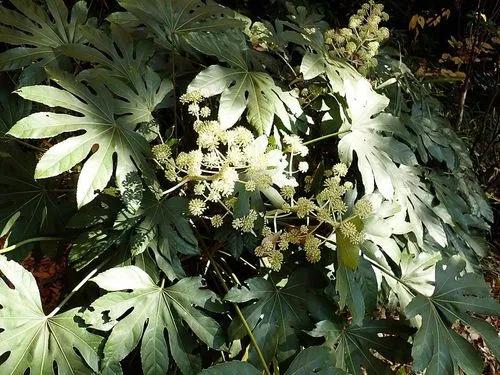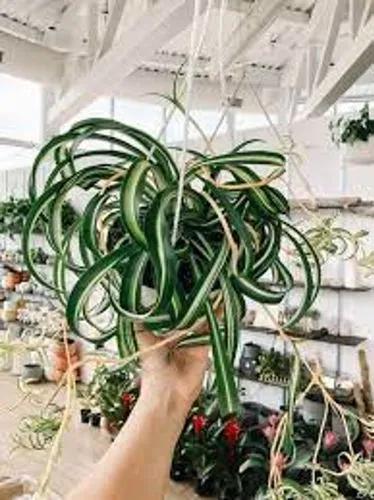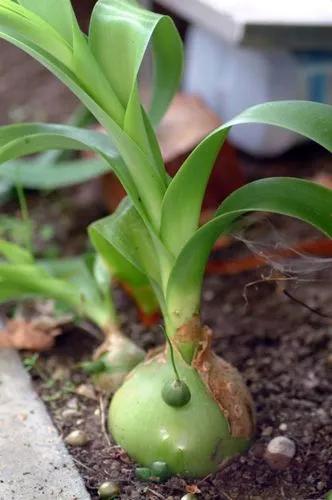It is an elongated, climbing or creeping herbaceous evergreen plant that reaches a height of 10–20 m with a sympodial growth type, lacking branches (branches off only after damage to the apical meristem), cylindrical to oval in cross-section. After the inflorescences have risen from the top of the stem, it stops growing, and from the side bud, placed two nodes below the top of the stem, a new main shoot is formed. The stem reaches several millimeters in diameter in juvenile plants and up to 6 cm in diameter (average of 1–2 cm) in mature plants. In juvenile plants, the stem is green and performs photosynthesis, but with age the plant cells stem lose chlorophyll. The climbing stalks have elongated internodes and are elastic to some extent, however, after bending the stem's skin often breaks and peels off, turning brown or yellowish. The stem in section shows a distinct layer of the plant directly under the skin of the stem. The border between the collenchyma and stem stem is poorly scratched. In the parenchyma, starch grains are randomly distributed. The tissue of the stem also contains idioblasts with calcium oxalate crystals and drusen. The stem also contains secretory cells, containing tannins and milk juice, which solidifies in the air. Just below each node there are two types of adventitious roots: a bundle of sticky roots and a single root, whose function is to supply the plant with nutrients. Twisting foliage with divergence 2/25, sometimes disturbed by slight twisting of the stem. Leaf petioles always form a distinct, wide vagina, with a length reaching from the middle to almost the top of the tail. The top of the vagina often ends slowly, it is pointed to the rounded. The petiole of species belonging to the informal oblongatum section is widened and extends beyond the base of the plaque. There are many intercellular air chambers in the tissues of the petioles, which makes them soft and brittle. In cross-section, the petioles are rounded on the axial side and individually ribbed on the axial side. The tails of juvenile leaves are often grooved. The leaf blades of the twigs are diverse on juveniles, transient and mature, differing in the shape of the plaque. Plants often begin flowering before the emergence of mature leaves, which led to misleading description of new types of twigs. Primitive pinnate pincers, converging to from 3 to 5 separate conductive beams. The marginal line located furthest from the edge of the plaque is the largest, formed by the lowest side veins. Further, smaller marginal lines are formed by higher, smaller primary veins or secondary veins. Often, the fourth and fifth marginal bundles are not visible to the naked eye. The use of the distal order creates retinal nerve.
Syngonium Care
Syngonium Erythrophyllum 'red Arrow'



How to Care for the Plant

Water

Water your arrowhead vine regularly during the spring and summer months, and reduce your watering cadence come winter. During the spring and summer, you want to allow your vine to dry out partially between waterings but never completely.

Fertilizer

Feed your arrowhead vine once a month with liquid fertilizer throughout the spring, summer, and fall months. You can halt feeding throughout winter when the plant will naturally slow its growth.

Sunlight

Arrowhead vine likes bright light but no direct sun. Diffused light is best, as harsh rays can burn or bleach the delicate leaves and vines.

Soil

Plant your arrowhead vine in a traditional soil-based potting mix. Arrowhead vines are prone to root rot, so you'll want to make sure whichever potting soil you choose is well-draining.

Temperature

If possible, maintain temperatures above 60 degrees Fahrenheit. While the plant can tolerate average humidity, it will thrive best with added moisture in the air.

Additional

Unfortunately for animal lovers, all parts of the arrowhead vine are toxic to most pets, including dogs and cats—though only mildly so.

Popularity

413 people already have this plant 54 people have added this plant to their wishlists
Discover more plants with the list below
Related articles






